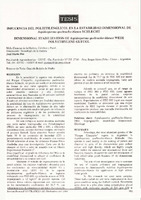Influencia del polietilenglicol en la estabilidad dimensional de Aspidosperma quebracho-blanco schlecht
Abstract
En Ia actualidad la especie mas abundante del Parque Chaqueño, Aspidosperma quebracho-blanco Schlecht, no puede ser usada en Ia elaboración de bienes de alto valor agregado, debido a su inestabilidad dimensional, a pesar de que posee un color amarillo cremoso y alta densidad, características muy buscadas en el mercado nacional e internacional de pisos y muebles.
Basado en ello esta tesis tiene por finalidad demostrar la posibilidad del uso de Aspidosperma quebracho-blanco en la elaboración de bienes de alto valor agregado, a través del estudio del grado de influencia de polímeros orgánicos y de los parámetros del proceso de impregnación en la estabilidad dimensional de esta especie.
En este trabajo se usaron muestras aserradas con torte radial, impregnadas con Polietilenglicol (PEG), de peso molecular 300 y 600, a diferentes concentraciones, durante distintos tiempos, utilizando el proceso Bethell. Estas muestras fueron secadas hasta 10% de contenido de humedad (CH) y posteriormente estabilizadas, de acuerdo con norma LRAM referentes al tema. Se utilizaron Plantas Piloto diseñadas para esta investigación. Cada uno de los ensayos se llevó a cabo de acuerdo con un Diseño Experimental Factorial 24. Para cuantificar el grado de influencia del PEG en la estabilidad dimensional se adoptó el coeficiente de retractabilidad y la contracción total.
Mediante el método de engrosamiento de la pared celular, los mejores resultados obtenidos para los coeficientes de retractabilidad (0,069 %) y contracción total (1,95 %) de Ia especie Aspidosperma quebracho-blanco, se lograron trabajando con PEG 600, en solución acuosa al 50%, impregnando a 12 kg/cm2 de presión durante 120 minutos. Estos valores representan una disminución en los mencionados coeficientes del 58,7 %, con referencia a los de esta especie sin tratar. La retención efectiva del polímero, en términos de estabilidad dimensional, fue de 73,7 kg de PEG 600 por metro cúbico de madera aserrada impregnada, valor que permite el uso del mismo a nivel industrial.
Además se constató que, en el rango de trabajo, el PEG 300 y PEG 600, como agentes hinchantes de la pared celular, mejoran sustancialmente la estabilidad dimensional de esta especie. Especialmente el PEG 600 logró una mayor estabilidad. También se determinó que una mayor retención de PEG lograda durante el proceso de impregnación produce una marcada disminución del coeficiente de retractabilidad. Nowadays, the most abundant species of the "Parque Chaqueflo" region in Argentina is Aspidosperma quebracho-blanco Schlecht. This species is used mainly in the making of pallets and charcoal in spite of its characteristic pale yellow colour and high density, which are highly sought after within the national and international floor and furniture markets. It cannot be used for production of high added-value goods because of its dimensional instability.
The aim of our investigation was to examine the use of organic polymers and impregnation processes to dimensionally stabilise Aspidosperma quebracho-blanco for application in high added-value goods.
In this research we used sawn samples. These had a radial cut and were impregnated in their green condition using the Bethel] method. Treatments were done in a pilot plant using polyethylene glycol (PEG) with molecular weight of 300 and 600 at different concentrations and different treatment times. The samples were dried to 10% moisture content and then stabilised under specific Argentine Institute of Material Rationalisation (RAM) standards. Each of the treatments was performed under a full factorial experimental design 24 .To measure the influence of PEG treatment on dimensional stability, differential swelling and shrinkage coefficients were adopted as control parameters.
The best differential swelling and shrinkage coefficients (0,069% and 1,95 % respectively) of the species Aspidosperniu quebracho-blanco were achieved by impregnating the wood with PEG 600 using a 50% aqueous solution folloWing the Balla process at a pressure of 12 kg/cm2 over two hours.
These results represent a decrease of 58,7 % in swelling compared with the untreated samples.
The best dimensional stability was achieved with a PEG 600 retention of 73,7 kg/m3 in the impregnated wood, which would allow its use in some industrial applications.
In addition,it was verified that using the above parameters the PEG 300 and PEG 600 bulking agents, improved the dimensional stability of the target species. The PEG 600 provided greater stability to the treated wood than the PEG 300. It was also shown that a greater retention of PEG, which had been achieved during the impregnation process, produced an important decrease in the differential swelling coefficient.
Collections
- Revista Yvyraretá [360]
The following license files are associated with this item:




